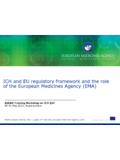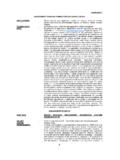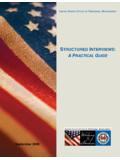Transcription of Antibiotic Dosing for Children: Draft expert ...
1 Antibiotic Dosing for children : Draft expert recommendations for the 2017 Essential Medicines List for children (EMLc) Purpose and Scope of recommendations expert recommendations for Antibiotic Dosing in the EMLc have been developed to address the lack of harmony in currently available international formularies. In many instances, recommendations are historical practise-based and not strongly evidence-based. Limited evidence is available from studies of effectiveness and safety as well as all age pharmacokinetics for children .
2 National preferences for weight-based (US), age-banded (UK) and weight-banded (WHO) Dosing strategies have resulted in quite widely varying recommendations . The rationale of this Dosing guidance has been to provide simple recommendations which are feasible in the LMIC context. Dosing guidance has been given as a single total daily dose (mg/kg/day) with options for acceptable frequency of Dosing which can be adapted to local context. A maximum upper dose has been provided, largely based on available adult Dosing . These recommendations have been developed for children ages 2 months to 12 years.
3 In general, the aim was to produce a simple Dosing guidance that covered all clinical infection syndromes, except severe infections such as meningitis, where significantly higher doses are recommended. Dosing recommendations have not been adjusted for children with renal or liver impairment. The recommendations have not accounted for global variation in rates of antimicrobial resistance. Using a single dose in this overall guidance does not reflect the range of doses that are actually required to translate the guidance into practical weight/age based formulations for children .
4 Methods For the development of these recommendations , the expert group comprised paediatricians, paediatric clinical pharmacologists and pharmacists based in the UK and Europe. Due to the predominance of low-quality and limited paediatric pharmacokinetic evidence, selection of doses was based on expert consensus after evaluation of available data. Antibiotic recommendations for eleven clinical syndromes (Community Acquired Pneumonia, Pharyngitis, Sinusitis, Otitis Media, Urinary Tract Infections, Meningitis, Central Catheter Infections, Complicated Intra-abdominal Infections, Skin and Soft Tissue Infections, Acute Infectious Diarrhoea and Infections in Immunocompromised hosts) were compiled from international guidelines (BNFC, Blue Book, IDSA/PIDS).
5 As there was very little available evidence for different Dosing for specific syndromes, a single dose was selected which was suitable for most indications. A higher dose has been indicated in special circumstances of severe infection. The Manual of Childhood Infections: The Blue Book (4th Edition) endorsed by the Royal College of Paediatrics and Child Health (RCPCH) and European Society of Paediatric Infectious Diseases (ESPID) was used as initial reference for Dosing recommendations . This handbook s Dosing guide, with an online publication of June 2016, was used as an up-to-date reference with grading of pharmacokinetic evidence within its development.
6 Where available, a repository of pharmacokinetic studies for each Antibiotic was consulted. Furthermore, the Red Book: 2015 Report of the Committee on Infectious Diseases (30th Edition) endorsed by the American Academy of Pediatrics Committee on Infectious Diseases and the 2017 British National Formulary for children (BNFC) online ( ) was reviewed. Paediatric guidelines from the Pediatric Infectious Diseases Society (PIDS) and the Infectious Diseases Society of America (IDSA) were retrieved by searching National Guideline Clearinghouse and PubMed.
7 Furthermore, WHO Institutional Repository for Information Sharing (IRIS) and Pocket book of hospital care for children (2013) were searched for available recommendations . The electronic Medicines Compendium (eMC) was also consulted to ensure that recommendations complied with available Summary of Product Characteristics documentation approved by the UK Medicines and Healthcare Products Regulatory Agency (MHRA) and the European Medicines Agency (EMA). Limitations and Further Research Further work is required to develop optimal paediatric Dosing recommendations for the use of common antibiotics in the LMIC setting.
8 Currently available pharmacokinetic data are limited, especially for the commonly used twice daily Dosing . There is a clear need for a prioritisation exercise of the key knowledge gaps to be addressed. Furthermore, the availability and use of generic formulations needs to be more clearly determined to ensure the feasibility of compliance to the summary Dosing guidance in the LMIC setting. Antibiotic Dosing for children : expert recommendations For children Ages 2 months to 12 years Dosing recommendations at a Glance Amikacin 15 mg/kg/day IV given once daily Cloxacillin.
9 Flucloxacillin 100 mg/kg/day IV divided in 2 or 4 doses Amoxicillin 100 mg/kg/day PO divided in 2 or 3 doses Doxycycline 5 mg/kg/day given once daily or in 2 doses Amoxicillin / clavulanic acid Amoxicillin component PO or IV 100 mg/kg/day divided in 2 or 3 doses Erythromycin 50 mg/kg/day PO or IV divided in 4 doses 100 mg/kg/day PO or IV in severe infections Ampicillin 100 mg/kg/day PO or IV divided in 2 or 4 doses 200 mg/kg/day PO or IV divided in 2 or 4 doses (in severe infection) Gentamicin 7 mg/kg/day IV given once daily Azithromycin 10 mg/kg/day PO given once daily Imipenem 60 mg/kg/day divided in 3 or 4 doses Aztreonam 100 mg/kg/day IV divided in 2 or 3 doses Levofloxacin 20 mg/kg/day PO divided in 2 doses Benzylpenicillin 100 mg/kg/day IV divided in 2 or 4 doses 200 mg/kg/day IV divided in 2 or 4 doses (in severe infection)
10 Linezolid 30 mg/kg/day PO or IV divided in 2 or 3 doses Cefalexin 50 mg/kg/day PO divided in 2 or 4 doses Meropenem 60 mg/kg/day IV divided in 3 doses 120 mg/kg/day IV divided in 3 doses (in severe infection) Cefazolin 50 mg/kg/day IV divided in 2 or 3 doses Metronidazole 20 mg/kg/day PO or IV divided in 2 or 3 doses Cefotaxime 150 mg/kg/day IV divided in 3 doses Moxifloxacin 10 mg/kg/day PO given once daily Ceftazidime 150 mg/kg/day IV divided in 3 doses Nitrofurantoin 4 mg/kg/day PO divided in 2 or 4 doses Ceftriaxone 80 mg/kg/day IV given once daily Phenoxymethylpenicillin 100 mg/kg/day PO divided in 2 or 4 doses 200 mg/kg/day PO divided in 2 or 4 doses in severe infection Cefuroxime 30 mg/kg/day PO or 100 mg/kg/day IV divided in 2 doses















